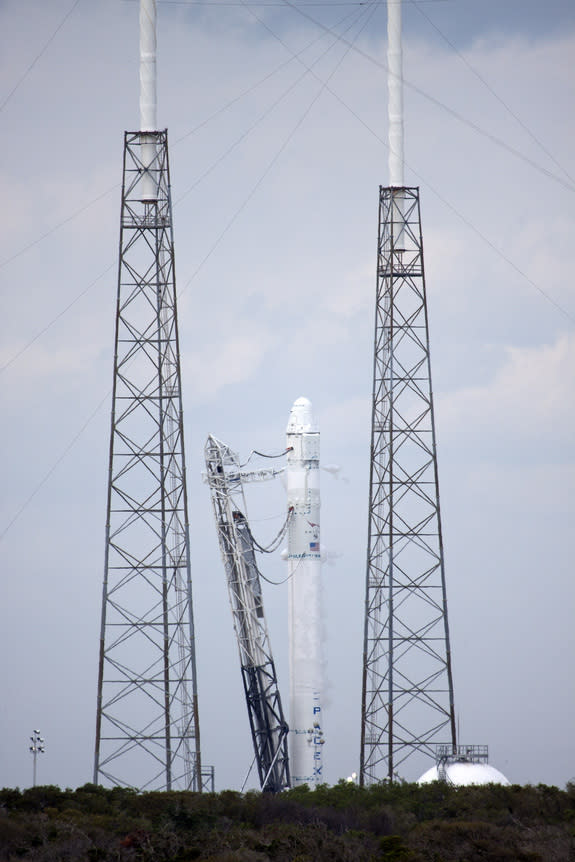Liftoff! SpaceX Launches Private Dragon Capsule to Space Station
CAPE CANAVERAL, Fla. — A privately built rocket lifted off over Florida Friday morning (March 1), in the second cargo delivery trip to the International Space Station by an unmanned, American-built spacecraft.
Developed and constructed by the private spaceflight firm SpaceX (Space Exploration Technologies Corp.), the robotic Dragon capsule left Earth atop the company's Falcon 9 rocket from a launch pad here at Cape Canaveral Air Force Station. Liftoff occurred on time at 10:10 a.m. ET (1510 GMT).
"I can't tell you how excited I am," SpaceX president Gwynne Shotwell said on Thursday in anticipation of the launch.
This mission is Hawthorne, Calif.-based SpaceX's second of a dozen contracted supply flights to the space station, part of a $1.6 billion agreement with NASA's Commercial Resupply Services Program. [6 Fun Facts About SpaceX]
Falcons and Dragons
The commercial space company was started in 2002 by billionaire entrepreneur Elon Musk, who also founded PayPal. The company's Falcon 9 rockets are named after the fictional Millennium Falcon spaceship from "Star Wars," while the Dragon capsules get their moniker from the song "Puff the Magic Dragon," Musk has said.
Although storms threatened central Florida earlier in the week, the skies cleared in time, and the rocket was "go" for liftoff.
The Dragon capsule will deliver 1,200 lbs (544 kilograms) of scientific experiments and supplies to the space station after docking on Saturday at 6:30 a.m. ET (1100 GMT). Among its bounty is food for the astronauts, including fruits picked from the orchard of a SpaceX employee's father, Shotwell said. The capsule is also carrying a copy of the song "Up in the Air" by the American rock band Thirty Minutes to Mars for NASA astronaut Thomas Marshburn, a flight engineer on the station.
The orbiting outpost is currently home to six crewmembers, led by Expedition 34 commander Kevin Ford of NASA. Ford and Marshburn will use the station's robotic arm to grab the Dragon capsule and attach it to the station, NASA officials said.
The flight will be Dragon's third visit to the space station, following a test flight in May 2012 and its first contracted cargo delivery mission in October of that year. SpaceX has taken precautions to avoid an engine anomaly that caused one of the Falcon 9's nine Merlin rocket engines to shut down during the October liftoff. Although the failure didn't prevent Dragon from docking safely to the station, it did cause a secondary payload, a prototype Orbcomm OG2 communications satellite, to miss its intended orbit and fall back to Earth.
Waiting astronauts
The residents of the space station have been preparing for Dragon's docking for some time, said Mike Suffredini, the manager of the International Space Station program office at Johnson Space Center in Houston. Engineers on the ground helped the astronauts update the space station's computers, including new upgrades to the software that controls the robotic arm that is expected to grab onto the capsule, Suffredini added.
If all goes according to plan, Dragon should stay attached to the football field-sized station until March 25, when the capsule returns to Earth, splashing down in the Pacific Ocean off the coast of Baja California, agency officials said.
NASA is funding these SpaceX missions in part to help replace the space agency's shuttle program, which NASA retired in July 2011. The agency also gave $1.9 billion to Virginia-based Orbital Science Corp. for eight cargo flights. That expenditure was part of the same program responsible for funding the SpaceX launch. Last week, Orbital Science Corp. successfully test-fired its Antares rocket, which the company will use in conjunction with its unmanned Cygnus capsule in transporting cargo to the space station.
Between the shuttle retirement and the launch of SpaceX's first cargo delivery flight in October 2012, NASA relied solely on spacecraft built by space agencies in Russia, Japan and Europe to send supplies to the station, but those vehicles aren't able to return cargo to Earth. Instead, the craft burn up in the planet's atmosphere.
Dragon, however, can bring cargo back to the ground to be studied or upgraded. This mission is slated to bring back about 2,300 lbs (1,043 kg) of space station material.
American spacecraft
The 14.4-foot-tall (4.4 meters), 12-foot-wide (3.6 m) Dragon capsule is the first solar powered American spacecraft to dock with the International Space Station.
The space agency still relies on Russian Soyuz spacecraft to bring astronauts to the space station, but that could change eventually. NASA officials hope that a commercial firm, perhaps SpaceX or Orbital Sciences, will have the capability to send a manned mission to low-Earth orbit by 2017.
SpaceX's next launch to the space station is scheduled for fall of this year.
Although sweeping federal budget cuts, dubbed the sequester, are set to go into effect today, the cuts should not affect SpaceX's partnership with NASA, at least in the short term, Shotwell said, and the space station program should be similarly unaffected, according to Suffredini.
Watch NASA astronauts attach the SpaceX Dragon capsule to the International Space Station live beginning on Saturday (March 2) at 3:30 a.m. ET (830 GMT) here on SPACE.com.
You can follow SPACE.com staff writer Miriam Kramer on Twitter @mirikramer. Follow SPACE.com on Twitter @Spacedotcom. We're also on Facebook & Google+. This article was first published on SPACE.com.
Copyright 2013 SPACE.com, a TechMediaNetwork company. All rights reserved. This material may not be published, broadcast, rewritten or redistributed.



